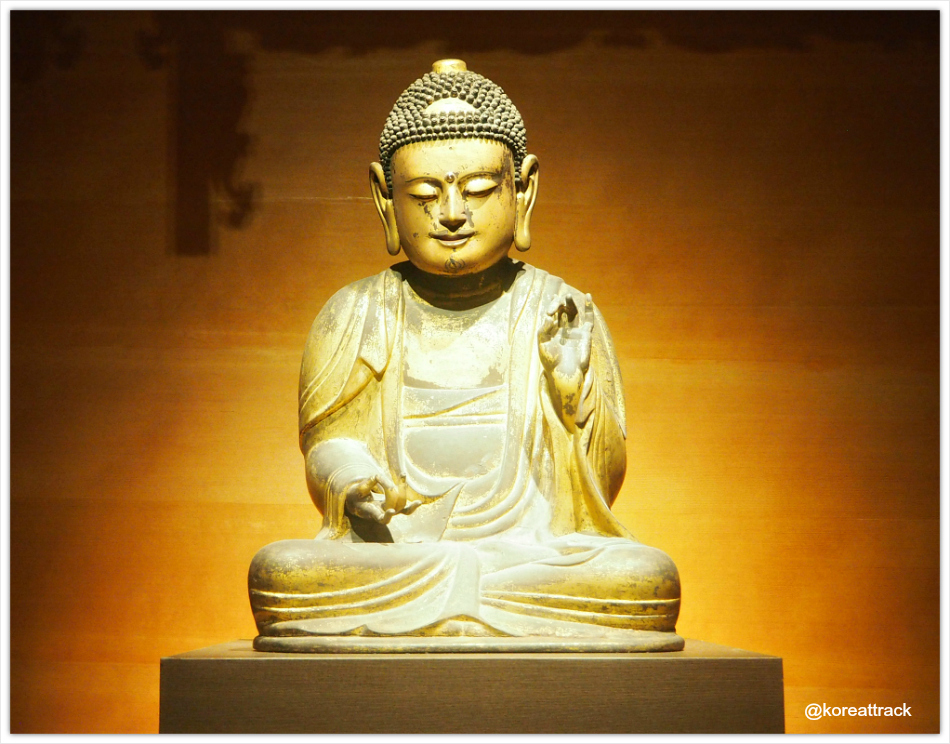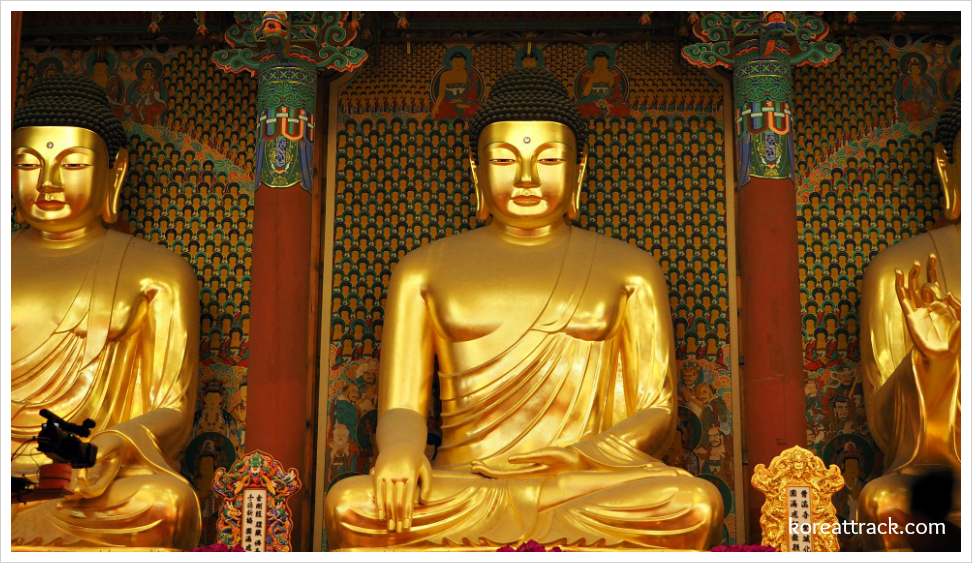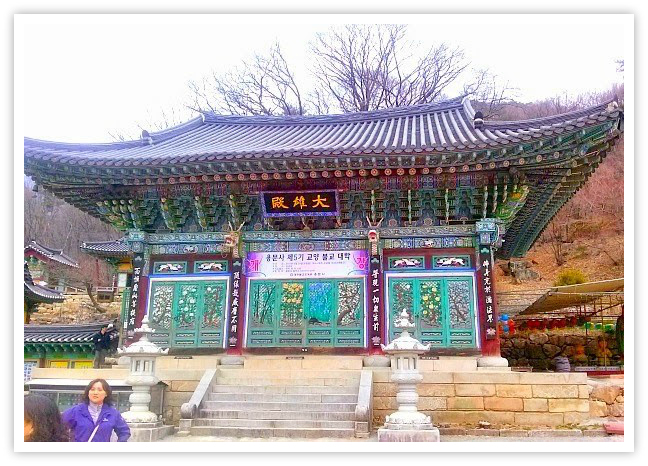Tongdosa Temple in
Yangsan City
 Tongdosa Temple in Yangsan City's main hall
Tongdosa Temple in Yangsan City's main hallTongdosa Temple in Yangsan
Tongdosa Temple in Yangsan City is a head temple of the Jogye Order of Korean Buddhism, situated in the southern part of Mt. Chiseosan near Yangsan, South Gyeongsang Province, South Korea.
It is one of the Three Jewels Temples and represents Gautama Buddha, while Haeinsa and Songgwangsa represent the Dharma or Buddhist teachings and the sangha or Buddhist community, respectively.
Tongdosa is renowned for its unique feature of having no statues outside the Buddha at the temple.
The "real shrines of the Buddha" or relics are preserved at Tongdosa, which makes it a significant place for Buddhists. The temple's courtyard is arranged around several pagodas that house the Buddha's relics.
The temple was founded by the monk Jajang-yulsa in 646 AD, during the reign of Queen Seondeok of Silla, after returning from Tang China. Tongdosa flourished throughout the Later Silla and Goryeo periods (918-1392) when Buddhism was the state religion, and even during Joseon, it remained strong.
![The two-pillared Gate [at Tongdosa Temple] depicts the architectural methods during the Joseon Period. tongdosa-temple-two-poles-gate](https://www.koreattrack.com/images/tongdosa-temple-two-poles-gate.jpg) The two-pillared Gate [at Tongdosa Temple] depicts the architectural methods during the Joseon Period.
The two-pillared Gate [at Tongdosa Temple] depicts the architectural methods during the Joseon Period.Origins of Tongdosa Temple
Tongdosa is known for housing several relics that belonged to Buddha himself. These include a robe, a begging bowl, and a bone from his skull. These relics were brought back to Korea by Jajang-yulsa, who traveled to Tang China in 636 to study with ten other monks.
Out of all the buildings in Tongdosa, only the Mahavira Hall, the main Dharma worship hall, survived the Japanese invasions of Korea between 1592 and 1598.
The other buildings were rebuilt later during that period. At the height of its prosperity in the mid-15th century, Tongdosa had hundreds of buildings and thousands of monks.
For more than 1,300 years, Tongdosa's Beopdeung, the temple candle, has never gone out.
 Tongdosa Temple area's main hall (Daeungjeon)
Tongdosa Temple area's main hall (Daeungjeon)Legends
According to legend, when Tongdosa was established, nine malevolent dragons resided in a large pond. Jajang-yulsa attempted to drive them away by reciting a magical text, but the dragons refused to leave.
So, Jajang-yulsa wrote the Chinese character for fire on a sheet of paper and threw it into the sky while using his long stick to splash the pond. This caused the water to boil, and the dragons couldn't withstand the heat.
Three of them tried to escape and flew off, but they became confused and perished by colliding into a cliff named Yonghyeolam (meaning "dragon blood rock").
The other five dragons flew southwest into a valley now known as Oryonggok (meaning "five dragon valley"). The last dragon, blinded by the heat, promised Jajang-yulsa that if he spared his life and allowed him to stay in the pond forever, the blind dragon would always protect the temple.
Jajang-yulsa granted the dragon's wish, and the dragon was permitted to remain the temple's guardian. The Nine Dragons Pond, now called Guryongji, remains next to the main temple hall.
Temple Features Today
 Tongdosa Temple and other temples
Tongdosa Temple and other templesTongdosa is Korea's most prominent temple, also known as "the temple without a Buddha," due to the absence of outdoor statues of Buddha.
Instead, it is built around various stupas containing the historical Buddha's relics, Jajang-yulsa. The road to the temple passes through a forest called "Pine trees dancing in the wind".
The temple has 65 different buildings, each serving as a shrine for various Buddhist deities. Though it is spread across the surrounding mountains, the temple is relatively small. In addition, there are 13 hermitages located on the temple complex grounds.
The architectural style of the buildings varies, with many being left unpainted or faded. One of the buildings has a beautiful mural that depicts a boat leading the deceased into paradise.
A museum on the temple grounds exhibits an impressive collection of artwork, and the temple currently houses 19 local treasures and 794 local cultural properties.
As one approaches the entrance, the first bridge that comes into view is Samseongbanwol, also known as the Three Arch Bridge. Its name means three stars and a half moon, sometimes called the One Mind Bridge.
The Chinese character for the bridge is made up of four strokes. The long stroke represents the half-moon, while the other three strokes signify the stars.
 A stone stupa at Tongdosa Temple. Stupas usually contain the remains of a holy monk.
A stone stupa at Tongdosa Temple. Stupas usually contain the remains of a holy monk.The first gate to the temple is called Iljumun, or the One-Pillar Gate. When viewed from the side, this gate appears to be supported by a single pillar, symbolizing the support of the world and the one true path to enlightenment. It also marks the boundary between the spiritual and secular worlds.
The next gate is the Gate of the Guardians of the Four Directions or Four Heavenly Kings. Each of these kings watches over one cardinal direction and is a protector of the world and a fighter against evil.
They can command a legion of supernatural creatures to safeguard the Dharma, which refers to the teachings of Buddhism.
 Tongdosa Temple in Yangsan - stone lamp & 5-story-stupa
Tongdosa Temple in Yangsan - stone lamp & 5-story-stupaThe third gate of the temple is called Purimun, also known as the Gate of Non-Duality.
This gate leads to a world of non-duality, where there is no distinction between the Buddha and human beings, being and non-being, good and evil, and fullness and emptiness. Over the years, Purimun has been rebuilt several times.
The current Gate of Non-Duality was constructed in the late Joseon Dynasty and was built to align with the One Pillar Gate, Guardian Gate, and Daeungjeon (main Dharma hall).
The Gate of Non-Duality is the leftmost structure in the first picture at the top of the page. Purimun, the Gate of Non-Duality, is designated South Gyeongsang Provincial Tangible Cultural Property #252.
Tongdosa is one of the five temples in Korea that are collectively known as Jeokmyeolbogung. These temples enshrine the relics of the Buddha that Jajang-yulsa brought back from China.
Tongdosa is also known as the 'Buddha Jewel Temple' because it houses Sari Jinsin, the Buddha's relics, in the Geumgang Gyedan (Diamond Altar).
This altar is a platform for the ceremony of prevailing Buddhist precepts and is located behind the main Dharma Hall, Daeungjeon.
Tongdosa does not have images of the Buddha or Bodhisattvas, unlike other worship halls. Instead, a Buddhist altar spans east to west inside, along the front with a window. This altar overlooks the Geumgang Gyedan.
Tongdosa's Daeungjeon has been designated National Treasure #290.
Getting to Tondosa Temple in Yangsan
Most public transports can either get close to the temple area or park inside the temple ground.
By Private Car
Take Gyeongbu Expressway Tongdosa Temple IC, then follow National Road 35 to reach Tongdosa Temple.
By Buses
From Busan Nopodong Bus Terminal, ride the Sinpyeong-bound bus (which runs every 20 minutes) and get off at Tongdosa Temple.
Alternatively, take the Busan-bound Cheonil general express bus and get off at Tongdosa Temple Interchange, then grab a bus (No. 13, 63, or 67) to reach Tongdosa Temple.
You can also ride Yangsan Bus No. 12, 13, 63, or 67 and get off at Tongdosa Temple.
By Train: Take KTX and then get off Ulsan Station, then catch Bus No. 13, 63, or 67 and get off at Tongdosa Temple.
Tongdosa Temple Address
If you speak limited Korean language skills, please use the Korean address below:
108 Tongdosa-ro, Habuk-myeon, Yangsan-si, Gyeongsangnam-do [경상남도 양산시 하북면 통도사로 108]
- Inquiries: +82-55-382-7182
- Operating hours: Open 24 hours daily
- Holiday: N/A (Open all year round) [Buddhist Museum] Mondays, Seollal (Lunar New Year's Day) & Chuseok (Korean Thanksgiving Day) holidays
- Parking: Available for all vehicle types
- Website: www.tongdosa.or.kr
- Home
- Temples in South Korea
- Tongdosa Temple in Yangsan
Get Exciting Activities
Book one of our exciting activities today to experience the thrill of a lifetime! Take advantage of this opportunity and secure your spot in advance.
Hotel Map Guide
Find your affordable, accessible, and comfortable hotel in Seoul at Agoda.Com. See the hotel map below...
Hotel Booking Guide
Find affordable and amazing hotels on Agoda.com using the search box below. Book now to enjoy great discounts and save!







New! Comments
What do you think about this page? Leave me a comment in the box below.